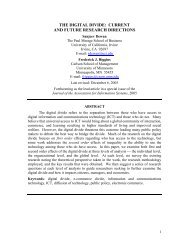When Should Software Firms Commercialize New Products ... - MISRC
When Should Software Firms Commercialize New Products ... - MISRC
When Should Software Firms Commercialize New Products ... - MISRC
You also want an ePaper? Increase the reach of your titles
YUMPU automatically turns print PDFs into web optimized ePapers that Google loves.
Proposition 4. Under SS model, the firm’s optimal seeding and pricing strategy, as well<br />
as the profit and social welfare associated with it are:<br />
k ∗ SS<br />
p ∗ SS<br />
π ∗ SS<br />
SW ∗ SS<br />
0 < α < 1<br />
2<br />
1−2α<br />
2(1−α)<br />
c<br />
4<br />
c<br />
16(1−α)<br />
c(11−16α)<br />
16(1−α)<br />
1<br />
2 ≤ α<br />
Interestingly, the firm only uses seeding when consumers significantly underestimate<br />
the true product value (α < 1<br />
2 ). In such cases, the firm has an incentive to increase the<br />
consumer willingness to pay by generating word of mouth. Furthermore, when α < 1<br />
2 , this<br />
benefit exceeds the cost of uniform seeding, whereby the firm gives away the product also<br />
to some of the high-type customers who would have purchased it even under low priors. As<br />
expected, the optimal seeding ratio is decreasing in α, which illustrates the fact that the<br />
higher the consumers’ priors on product value (and, implicitly, the higher the willingness<br />
to pay), the lower the need to seed the market.<br />
6.2 Complex Seeding - CS<br />
In this model, in period 1, in addition to seeding, the firm also sells the software. Word<br />
of mouth from the seeded community gets around even when nobody else purchases the<br />
product in the first period. Therefore, the feasible price condition (4) becomes:<br />
0 < p < max{2cα,c[α +k(1−α)]}. (12)<br />
<strong>When</strong> constraint (12) is satisfied, adoption occurs in either period 1, period 2, or both.<br />
In particular, adoption (in addition to seeded customers) starts in period 1 if and only if<br />
p < 2cα. We note that 2cα < c[α+k(1−α)] if and only if α < k<br />
1+k . Therefore, for prices<br />
in the feasible range, we have:<br />
⎧<br />
⎪⎨<br />
θ1 =<br />
⎪⎩<br />
p k<br />
2cα , if 1+k ≤ α,<br />
p<br />
2cα , if 0 < α < k<br />
1+k<br />
1 , if 0 < α < k<br />
1+k<br />
and p < 2cα,<br />
0<br />
cα<br />
2<br />
cα<br />
4<br />
3c<br />
8<br />
and 2cα ≤ p < c[α+(1−α)k],<br />
18<br />
(13)
















